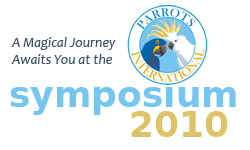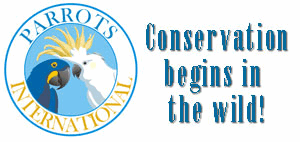2009 - Issue 3
Reducing the Trapping of Endangered Parrots
By Bonnie Zimmermann and Stewart Metz, MD , The root causes of parrot trapping are multifactorial. Despite this, there is a tendency, probably ill-placed, to focus overly on legal measures designed to reduce poaching. However, by the time parrots, cockatoos and lorikeets can be recovered from the authorities, their fate is practically sealed and is usually characterized either by death, or a lifetime of neglect, poor treatment and imprisonment in tiny cages.
By Bonnie Zimmermann and Stewart Metz, MD , The root causes of parrot trapping are multifactorial. Despite this, there is a tendency, probably ill-placed, to focus overly on legal measures designed to reduce poaching. However, by the time parrots, cockatoos and lorikeets can be recovered from the authorities, their fate is practically sealed and is usually characterized either by death, or a lifetime of neglect, poor treatment and imprisonment in tiny cages.
Unwanted Birds - Problems and Solutions
By Dorothy Schwarz , Are birds considered anything more than an object we can buy and sell? At present the answer is that they aren't. They are classed as pets. Pets are bred for our amusement and pleasure. This is a profitable business, not only for breeders, but also for traders supplying birds' food, equipment and toys. Opposing these practices are welfare organizations and charities, many of which are written about in the avian press.
By Dorothy Schwarz , Are birds considered anything more than an object we can buy and sell? At present the answer is that they aren't. They are classed as pets. Pets are bred for our amusement and pleasure. This is a profitable business, not only for breeders, but also for traders supplying birds' food, equipment and toys. Opposing these practices are welfare organizations and charities, many of which are written about in the avian press.
Artificial Cavities and Nest Site Selection by Puerto Rican Parrots:
A Multiscale Assessment
By Thomas H White Jr, G Gordon Brown and Jaime A Collazo A Multiscale Assessment" class="left" width="80px" height="80px"/>, The Puerto Rican Parrot is unique in that, since 2001, all known nesting in the wild has occurred in standardized artificial cavities, which also provided us a unique opportunity to evaluate nest site selection without confounding effects of the actual nest cavity characteristics.
A Multiscale Assessment
By Thomas H White Jr, G Gordon Brown and Jaime A Collazo A Multiscale Assessment" class="left" width="80px" height="80px"/>, The Puerto Rican Parrot is unique in that, since 2001, all known nesting in the wild has occurred in standardized artificial cavities, which also provided us a unique opportunity to evaluate nest site selection without confounding effects of the actual nest cavity characteristics.
Intuitive Parrot Feeding
By Gudrun Maybaum , Between all the different diets that we can find these days, there is one called intuitive eating. It teaches us how to get in touch with our body and recognize the messages it gives us.
By Gudrun Maybaum , Between all the different diets that we can find these days, there is one called intuitive eating. It teaches us how to get in touch with our body and recognize the messages it gives us.
The Lymington Foundation - Juquitiba, Sao Paulo, Brasil
By Bill Wittkoff , We fell in love with parrots in the last century (1998) when we got our first pair of Amazons for Christmas. Then fortune gave us an unsexed pair of Blue and Golds which, on being set up in a small apartment, decided to become prolific and give us 16 babies, one clutch after another. In 2000 we started to get serious, with the acquisition of a breeding license from the ministry of environment (IBAMA).
By Bill Wittkoff , We fell in love with parrots in the last century (1998) when we got our first pair of Amazons for Christmas. Then fortune gave us an unsexed pair of Blue and Golds which, on being set up in a small apartment, decided to become prolific and give us 16 babies, one clutch after another. In 2000 we started to get serious, with the acquisition of a breeding license from the ministry of environment (IBAMA).
Straight Talk About Behaviour
By By Susan Friedman, PhD , Have you ever heard the expression, "It's like herdin' cats"? That describes some of the best days working on our internet list, Parrot Behavior Analysis Solutions (PBAS; www.yahoogroups.com). PBAS is not a chat group; it's a special interest work group dedicated to applying the scientific principles of behavior to living and learning with companion parrots.
By By Susan Friedman, PhD , Have you ever heard the expression, "It's like herdin' cats"? That describes some of the best days working on our internet list, Parrot Behavior Analysis Solutions (PBAS; www.yahoogroups.com). PBAS is not a chat group; it's a special interest work group dedicated to applying the scientific principles of behavior to living and learning with companion parrots.
Serious Cause for Concern - New Zealand’s Parrots in the 21st Century
By Rosemary Low , New Zealand (104,000 sq miles) is slightly larger than the UK (94,500 sq miles), yet it has a human population of only 4.2 million. The UK's human density per square mile is 245. New Zealand's is 16! If you think this means its wildlife must be thriving, you would be totally wrong.
By Rosemary Low , New Zealand (104,000 sq miles) is slightly larger than the UK (94,500 sq miles), yet it has a human population of only 4.2 million. The UK's human density per square mile is 245. New Zealand's is 16! If you think this means its wildlife must be thriving, you would be totally wrong.






























